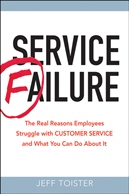Self-service or customer service?
 Jeff Toister
Jeff Toister  Monday, September 26, 2011 at 3:56PM |
Monday, September 26, 2011 at 3:56PM | I read an article today that said many supermarkets were re-thinking the strategy of installing self-service checkout stands. Some customers seemed to like them while many customers found it easier or more pleasant to have a cashier ring up their purchases. (Read the article here.)
The article reminded me of an oft-asked question: Should we offer self-service or customer service?
My response is that’s the wrong question.
When self-service is great, it’s really great. Printing out my boarding pass at an airport kiosk or downloading it to my smart phone is a terrific time saver compared to waiting in line for a ticket agent. Looking up nearby coffee houses on a website or mobile app is much easier than spending 10 minutes calling a 1-800 number to get directions. Visiting a software company’s online learning center is much faster for me than signing up to take a class.
On the other hand, self-service can waste of time, cost money, and be extremely aggravating. Automated phone menus at the other end of 1-800 numbers often needlessly waste five minutes or more of my time before I can get to a person who can actually help. I don’t appreciate being charged a $7.50 “convenience fee” if I want to buy tickets to a play or sporting event online when I can buy them in person from a box office agent without paying a self-service surcharge. And, I really don’t like feeling like an idiot while I’m trying in vain to scan, bag, and pay for my groceries faster than the cashier in the checkout line.
Companies considering a self-service or automated option should start by asking themselves, “How can I offer the best possible service at the lowest possible cost?” These aren’t mutually exclusive options. Rather, they are counterpoints to a balancing act between a genuine desire to make every customer ecstatic about your business and the need to maintain fiscal responsibility.
Perhaps the best quote in the article was from Suzi Robinson, a spokesperson for Stop & Shop Supermarket Co. who explained why the company has self-serve lanes in about 85% of their stores. “Our philosophy is giving customers options. People shop in different ways and we want to accommodate their preferences.”




Reader Comments (2)
Asking the right question is key.
When you ask the wrong question, you'll only reach the right answer by complete accident ... in other words, it's exceedingly unlikely to happen.
"Either/or" questions - as in your example here - are likely to be the wrong question.
The real question is, what's the actual goal? In the case of self-service versus customer service, what's the company making the choice trying to accomplish?
As Costco discovered, the apparent savings of putting in self-checkout lanes dissolved when they had to keep unscrambling people who couldn't get things to work right ... never mind the increased security necessary to try to prevent shoplifting ... never mind the fact that shoplifting increased anyway (according to my informal conversations with Costco employees when I noticed the self-serve lanes were gone).
In my experience, either/or questions are a direct route to the Painful Law of Unintended Outcomes.
Much better to stop and ask ... um, what exactly are we trying to achieve? And in the case of customer service issues, what hidden costs or unintended customer experience outcomes might we be inviting?
Great point, Grace! I'm not a big fan of "either/or" questions in business either.